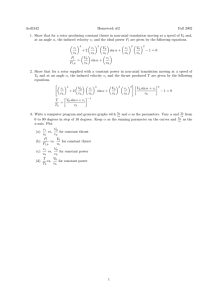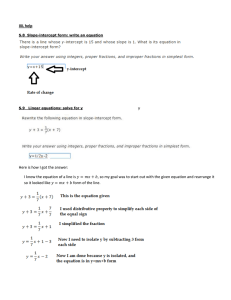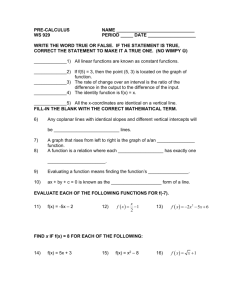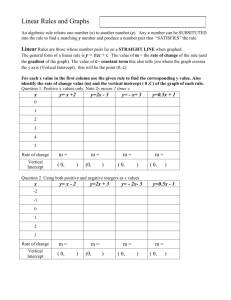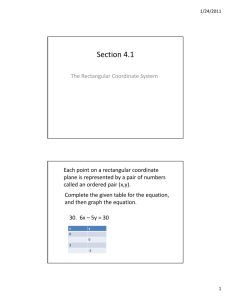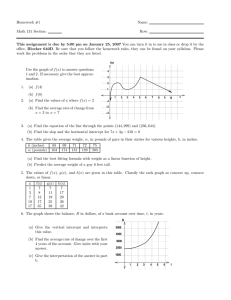1966 JUL 1 A RIE6
advertisement
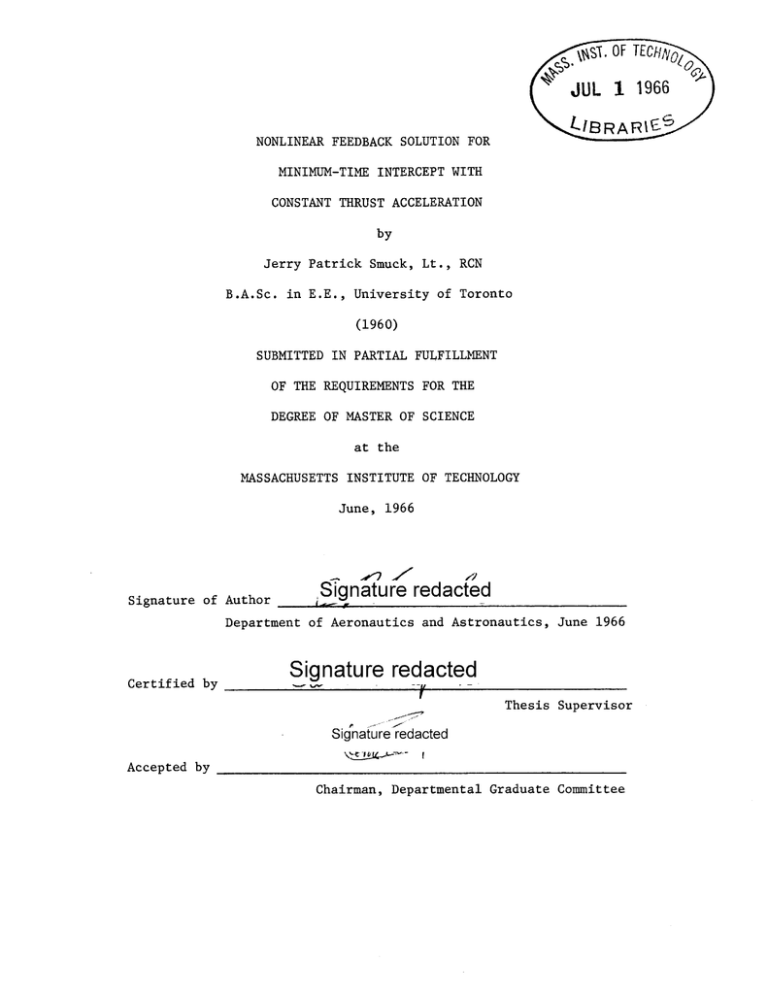
4 \%Sj. OF TECHplo, JUL 1 1966 ~SR A RIE6 NONLINEAR FEEDBACK SOLUTION FOR MINIMUM-TIME INTERCEPT WITH CONSTANT THRUST ACCELERATION by Jerry Patrick Smuck, Lt., RCN B.A.Sc. in E.E., University of Toronto (1960) SUBMITTED IN PARTIAL FULFILLMENT OF THE REQUIREMENTS FOR THE DEGREE OF MASTER OF SCIENCE at the MASSACHUSETTS INSTITUTE OF TECHNOLOGY June, 1966 Signature of Author Signature redacted Department of Aeronautics and Astronautics, June 1966 Certified by Signature redacted Thesis Supervisor Signature redacted Accepted by Chairman, Departmental Graduate Committee C A C) NONLINEAR FEEDBACK SOLUTION FOR MINIMUM-TIME INTERCEPT WITH CONSTANT THRUST ACCELERATION by Jerry P. Smuck Submitted to the Department of Aeronautics and Astronautics on 20 May 1966 in partial fulfillment of the requirements for the degree of Master of Science. ABSTRACT The instantaneous thrust-direction for a missile to carry out a minimum-time intercept with a non-maneuvering target is determined as a function of instantaneous relative velocity and position. The magnitude of the thrust acceleration is assumed constant and the acceleration due to external forces is neglected. This six-coordinate problem (three relative position coordinates and three relative velocity coordinates) can be reduced to a problem in two coordinates, namely V 2 /2ar and y, where a is the magnitude of the thrust acceleration, V is the magnitude of the relative velocity, r is the distance between the missile and the target, and y is the angle between the relative velocity vector and the line-of-sight between the missile and the target. Natural quantities to measure during the intercept maneuver are r, r, and a, where a is the rate of rotation of the line of sight relative to a fixed reference axis. The two dimensionless coordinates in terms of these measured quantities are: v2 2ar (ra)2 (r) 2ar tany= ry (-r) Let e be the angle between the thrust vector and the line-of-sight, and 0 and aT for minimum-time intercept are let T be the time-to-intercept. V iii given, both analytically and graphically, as functions of V 2 /2ar and y. The analytic solutions are transcendental equations V2 2ar = sin 2 e 4siny sin(e+y) and aT V _ 2siny sine Thesis Supervisor: Title: Arthur E. Bryson, Jr. Professor of Aeronautics and Astronautics iv ACKNOWLEDGEMENTS The author wishes to express his appreciation to Dr. A.E. Bryson, who suggested the thesis topic and served as thesis supervisor. ~ I V TABLE OF CONTENTS Chapter No. Page No. 1 Introduction 1 2 Minimum-time Intercept Using Continually Varying Thrust Direction 2 Reduction of Minimum-time Intercept to a Two-Coordinate Problem 4 4 Development of the Barrier Equation 6 5 The Minimum Thrusting-time Intercept Problem 8 3 6 Implementation of Results 10 7 Conclusions 11 Figures 1 The Minimum-time Intercept Problem 2,3 Optimal Thrust Direction, 6, as a Function of V 2 /2ar and y 4 aT/V as a Function of V 2 /2ar and y 5 Optimal Paths for Minimum-time Intercept as a Function of V 2 /2ar and y 6 Minimum-time Intercept -- Two Stationary Paths from Same Initial Point 7 The Minimum Thrusting-time Intercept Problem 8 Optimal Paths for Minimum Thrusting-time Intercept as a Function of V 2 /2ar and y References 1 Bryson, A.E., "Nonlinear Feedback Solution for Minimum-time Rendezvous with Constant Thrust Acceleration," Cruft Laboratory Technical Report No. 478, July 15, 1965. -A CHAPTER 1 INTRODUCTION The intercept maneuver consists of bringing the relative position of a pursuer with respect to a target to zero. almost certainly be required to do it. Feedback control will This thesis considers the intercept feedback control for the case where the target is not maneuvering and the pursuing vehicle has a thrust acceleration of constant magnitude, a, but a controllable direction. External forces are neglected, or equivalently the external forces per unit mass (such as gravity) are assumed to be constant in magnitude and direction during the maneuver. This latter assumption is reasonably good for nearly-circular satellite orbits if the maneuver time is short enough that the angular distance travelled around the attracting center is smaller than 30* to 40*1. I 2 CHAPTER 2 MINIMUM-TIME INTERCEPT USING CONTINUALLY VARYING THRUST DIRECTION Consider the origin in the target, which is assumed to be moving with constant velocity with respect to an inertial coordinate system. The intercepting vehicle must then bring its position to zero in minimum time. The problem is two-dimensional since the target, the intercepting vehicle, and the relative velocity vector determine a maneuvering plane. The equations of motion for the intercepting vehicle are: u = -a cose (2.1) v = -a sine (2.2) U (2.3) y = v (2.4) x= where u and v are velocity components, x and y are position components, and the magnitude of the thrust acceleration, a, is assumed constant. (See Figure 1) The Hamiltonian of the system is H 1 = a cose - X X - v u a sine +A x u +X y v (2.5) Thus the Euler-Lagrange equations are = -(2.6)DH = - - -X -- = (2.7) y 5v v 0 (2.8) 0 (2.9) 7 x = y - = - H y - = 0= 36u X a sinO-X v a cosO (2.10) 3 Since u and v are not specified at time t = T when the intercept occurs, the influence functions Xu and-VX at this time are zero. Equations (2.6) to (2.9) may be integrated to yield X =X (T-t) x (2.11) X =X (2.12) u V (T-t) y S= constant (2.13) X = constant y (2.14) x Combining equations (2.11) to (2.14) with equation (2.10) yields tan 0 = constant (2.15) or e = constant (2.16) 4 CHAPTER 3 REDUCTION OF MINIMUM-TIME INTERCEPT TO A TWO COORDINATE PROBLEM Recalling that x = 0 = y at t + T, the time of intercept, and that equation (2.16) states that the control angle 6 is a constant, equations (2.1) to (2.4) may be integrated to yield 0 = r - VT cos y - 1/2 (a cose) T2 (3.1) 0 = VT sin y - 1/2 (a sine) T2 (3.2) Equation (3.2) yields T = 2V siny a sine (3.3) T = 0 (3.4) or Substituting equation (3.3) into (3.1) yields 2V 2 cos ysiny a sinG + 2V 2 sin Y cose a sinz6 (3.5) which may be simplified to 1 =2 4siny sin(O+y) 2ar sin -e (3.6) Thus the transcendental equation in terms of the two coordinates V2 /ar and y for the optimal control angle 6, which produces a minimum-time intercept is V2 2ar sin2 e 4siny sin(e+y) (3.7) Figure 2 and Figure 3 show curves of constant thrust angle plotted versus the dimensionless parameters V2 /2ar and Y. If a dimensionless time to go X = aT V (3.8) is designated, then substitution of equation (3.8) into (3.3) yields X - 2(3n s ine (3.9) 5 and substitution of equation (3.9) into (3.7) yields V2 = 2ar sin 2X sin(6+y) (3.10) which may be further simplified to V2 2ar 1 X [2cosy + VX - 4sin2 y] (3.11) Equation (3.11) is a transcendental equation for the dimensionless time to go 2 in terms of the two dimensionless parameters aT Figure 4 shows some curves of constant a -V and y. V2 y. plotted versus - 2arnd ady V2 Figure 5 shows some optimal paths plotted versus 2ar and y. Figures 2, 3, 4 and 5 all show a barrier which is discussed in detail in Chapter 4. 6 CHAPTER 4 DEVELOPNENT OF THE BARRIER EQUATION In Chapter 2, it was shown that a constant thrust angle with respect to an inertial reference line is required to achieve a minimum-time In some cases there exist two control angles resulting in intercept. two paths which accomplish the intercept, with one path being a local minimum and the other being the global minimum. Figure 6 shows an example of two possible paths with constant thrust angle from the same initial point. As can be seen in Figure 6, there is one path where the interceptor thrusts in the general direction of the target in order to rotate its velocity vector directly towards the target and thus accomplish the The other path is one where the interceptor uses its thrust to intercept. first slow down, then turns to come back to hit the target. path takes a longer period of time than the first. This second It is easily seen that if the initial conditions in Figure 6 were altered sufficiently, the interceptor would find there is a set of initial conditions where it can no longer thrust in the general direction of the target in order to hit it, but must thrust to first slow down, then reverse direction and come back to hit the target. This set of initial conditions determines a barrier, the equation of which will now be developed. V2 a -=f(y,6) - 2ar 2 0 + sin f 4siny sin(e:+Y) y _sin where Let (4.1) (4.2) 7 dy + dy = - and (4.3) -- do For the barrier -f=_ 0 1 3- 4siny [sin(O+y) 2 sine cos6 - sin 2 e cos(e+y)I (4.4) therefore sine cose cosy + cos 2 0 siny + siny = 0 (4.5) which leads to cosO = V 1/2 [1 - 3sin 2 y cosyV 1 - 9sin2Y ] (4.6) If Figure 2 is initially plotted without the barrier, it can be seen that for y > 0 the barrier exists at values of is also the Y = 0 line. cose = -v/1/2[l e > 0 since the value e = 0 Equation (4.6) may then be reduced to - 3sin 2 y - cosy/ 1- 9sin 2 Y j It can then be shown that the barrier starts at y = (4.7) 0*, -2 - = o and follows equation (4.7) to its limit at y=19.5*, 2ar 2 V and 2ar = .866. 6 = 900, 6 =125.2* i:1 8 CHAPTER 5 THE MINIMUM THRUSTING-TIME INTERCEPT PROBLEM If the interceptor is only able to start its engine once, and if the engine is to be kept on until intercept, then the minimum thrusting-time solution will be of interest. Figure 7 shows the situation where the interceptor is coasting towards the target with constant relative velocity V , and, if no thrust were applied, the interceptor would miss the target This and other straight line coasting paths will show by a distance y0 . 2 as sine curves on figures plotting V /2ar against y, with the paths commenc2 ing at V 2 /2ar = 0, y = 0 and going to V /2ar = 0, y = 1800. This is v2 2ar 2 Vo =ysiny 0 . easily shown since along the straight line paths (5.1) iayo The minimum thrusting-time problem is the determination of the position at which the engine should be turned on, and the direction in which to thrust. The solution to this problem is to thrust normal to the velocity vector Vo and to commence thrusting at that position which leads to intercept if the thrust is applied normal to the velocity vector Vo. Figure 1 shows that the angle between the velocity and the acceleration is the sum of the angles e and y. Thus at the starting point 0 + Y = 90* (5.2) The locus of starting points described by equation 5.2 is shown on 9 Figure 8 with minimum thrusting-time paths added. Figure 8 shows that the interceptor must immediately start its engine and follow a minimum time path if the initial conditions place the point VO 2 /2ar and y to the right of the starting locus, or otherwise the interceptor must coast to the starting locus. U 10 CHAPTER 6 IMPLEMENTATION OF RESULTS For a missile to utilize the results obtained in the previous chapters, Figures 2, 3, 4 and 8 could be stored digitally in the memory of a missile computer. The missile would then measure r, r and a, compute V 2 /2ar and y, and then refer to its memory to obtain the optimum control angle 6. This cycle would then be repeated as often as the missile could perform the necessary measurements and computations. With a digital storage of the nonlinear feedback law, it would be necessary to use an interpolation scheme to obtain the control angle 6. The total differential of equation (3.7) yields AV 22 /2ar Ae = V /2ar + [coty + cot (6+y)]Ay V2/2ar 2cotO - cot(6+y) (6.1) Even if the missile does not apply the exact optimal control angle 6, it will nevertheless thrust in a direction such as to create a near miss. Using an interpolation scheme based on equation (6.1), it can be seen that as the missile gets closer and closer to the target, the amount of interpolation required becomes less and less. The method described to effect a minimum-time intercept appears feasible; with the amount of information about the optimal control law stored in the missile computer being dependent upon the missile characteristics. -4 11 CHAPTER 7 CONCLUSIONS Continuous nonlinear feedback laws have been obtained for controlling the thrust direction to effect a minimum-time intercept and a minimum thrusting-time intercept of a pursuer with a non-maneuvering target. These feedback laws depend on only two dimensionless quantities which can be determined by measurements of three physical quantities: (1) distance to the target, (2) closing velocity along the line of sight, and (3) rate of rotation of the line-of-sight with respect to an inertial axis in the maneuver plane. A method of implementing these feedback laws was also presented. VT TARGET r e a. FIGURE 1 INTER- CE P TO R - ~- rO 0 .. 30' .6 45' 60 FIGURE 75 3 .8 A 00 * ~ '35 165 BARRI ISO Y. R 10 6o 3* 00 FIGURE 2 OPTIMAL 96 THRUST 'V500 DIRECTION ,G, A& A FUACTiON OF V/zar AND 0:300 40' so 60 70 0 8 1O' 1o - 8 0. 1.0 'R 166 44406 . F60 I5 G5 R Is 166 166 164 6Z7 /6 6 1 8 * 1 6" 15Z 1 V .6 . 0 .4 ta~r .0 1.0 BA RRIE R U-. 2.oi 'L.. /1"I 0 D0 S it 3;: FIGURE l'0' 4 -so 6e aT '1 U. *lo AS lo A 'T FUNCTIOAI OF 116. VI Zo~t I P.0r $AD Y I 30 140150 I~O*4o* 1110 I I I 4 - 4 I 00 I .2. .4 Vt 2aV .6 .8 L BARRIER .6 \OPTIMAL .4 PATH 5 4 .1~ 0 v - j 3o' 0 FIGUR E 5 60' 90 0 O PT I M A L PATHS FOR MINIMUM-TIME AS A V/Z ar FUNCTION 0 F A ND 1a 0' I NTE R-CEPT ISO 0* 6 F16 U RE MINIMUM TIME INTERCEPTTWO STATIONARY PATHS FROM SAME INITIAL POINT y ro aT 0.2 =1.38 14.00 V= RE TA RGET 2aro T0 * a .50 1.0 0.5 ar 0.90 -1 L Ir V 30I I x L. F, FIGURE 7 od I k T I moo A I * o -- .00~ .2Z COAST/46 PATH -o'le5TAR / .+ Va -- L OCUS jar .8 / - . -r I ,.BARRIER Vt .4 PATH 5 .1. x * V 1 1~~~~ 0 30 FIGUR E 8 60' -- 5 90' PATHS FOR MINIMUM O PT I M A L 0 F V'/Zare AS A FUNCTION U. lzo. THRUSTING-TIME AN D V I 1500 INTERCEPT - 1800 0

